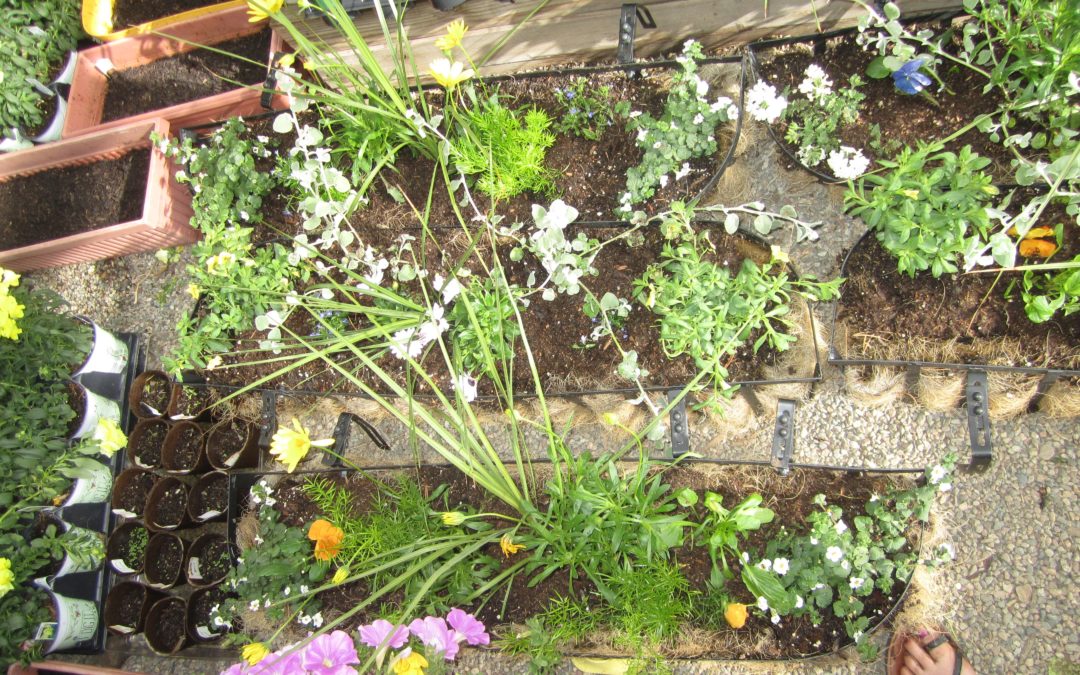With much relief, the sun has finally decided to make an appearance in Summit County. As the trails around the county begin to dry out, the Columbines begin to bud, and temperatures rise, the wait to plant annuals and perennials grows shorter. At least a month behind Denver, June 15th is an unwritten rule in Summit County for frost-free days and nights. But we all know that cold nights and even snow could happen anytime, so being aware of nights with temperatures lower than 32 degrees are important throughout the summer.
Annuals vs. Perennials
A perennial gardener at heart, I will always have a soft spot for hanging baskets and containers. While annuals and perennials are favorable in their own way, I suggest using Annual flowers for containers and to fill in empty spots in your garden beds. Perennials are hard to overwinter in containers here in Summit County, so are a preferable choice for ground beds. I would not choose one or the other, but a combination of both.
Annuals
- Grow for just 1 season (some reseed better than others, creating NEW plants the next season)
- With proper care and maintenance annuals bloom all season long
- Cannot handle freezes (a few exceptions like Pansies and Violas)
- Great in hanging baskets, containers, and to fill in gardens for instant color
- Typically require more water, depending on container/location
- Instant and ongoing color
Perennials
- Go dormant over the winter and return for several seasons.
- Typically bloom 4-6 weeks in Spring, Summer, or Fall.
- If plant hardiness is proper for your zone (In Summit I typically use zone 2,3,4 plants), perennials can be planted as soon as the ground is workable.
- With proper maintenance and care perennials can require less water and resources over time after the plants are established.
- Perennials typically take 2-5 seasons to reach their mature size so patience is important and definitely worth it.
Planting Tips for Annuals
Make sure you choose the proper plant for the exposure of your area. Shade plants can handle more sun in Summit County since our temperatures are not as hot.
- Planting depth should be flush with the top of the crown of your plant. You do not want your plant sitting too low or too high.
- Using your hands or a hand tool, break apart the roots of your plant. You can be pretty aggressive when doing this.
- Add an organic starting fertilizer ( I like Happy Frog Starter Fertilizer, Age Old Organic Root Rally, and Bone Meal) to all new plantings. Unless you already amended your planting area with compost, adding local compost to new plantings is also a good idea.
- Specifically for containers, use the thriller, filler, spiller method.
- Thriller plants are the star of your container. Typically upright and tallest, they should catch your attention first.
- Filler plants are typically mounding and supportive to your thriller plant, filling in around the thriller.
- Spillers typically have a cascading growth habit and spill over the sides of your container.
- Deeply water new plantings and add more soil where required.
Planting Tips for Perennials
Always space plant properly, allowing room for the plant to reach mature size. Plant tags will be pretty specific about planting spacing and mature plant sizes. Keep in mind that our shorter seasons can make it hard for some plants to reach their full size in Summit County, but overcrowding is not endorsed.
- Using your hands or a hand tool, break apart the roots of your plant. You can be pretty aggressive when doing this.
- Add an organic starting fertilizer ( I like Happy Frog Starter Fertilizer, Age Old Organic Root Rally, and Bone Meal) to all new plantings. Unless you already amended your planting area with compost, adding local compost to new plantings is also a good idea.
- Perennials that are not blooming at the time of planting actually root faster as they are not using their energy to bloom.
- Choose a combination of Spring, Summer and Fall blooming perennials so you always have some color in your garden.
- For ground beds add 2 inches of compost or mulch around plants to conserve moisture and deter weeds. In areas immensely planted I recommend using compost as your mulch. I also recommend never using any colored or dyed mulches. Why add more chemicals to your plants?
Favored Plants and Nurseries
When shopping for your plants remember to always shop at a local nursery. Most big box shops have a set plant list not specific to our climate and area, and the use of harmful chemicals on these plants has been debated. I only recommend shopping for tools and hard goods – never plants – at these stores. Your local nursery can provide you Summit County specific availabilities, resources, and knowledge. I recommend Alpine Earth Center in Silverthorne and Mountain Grown Gardens in Alma.
Resources for Summit County plant lists include http://summitcountygardenclub.org.
There is a Colorado specific program called Plant Select that tests new different perennial plants for Colorado. Some are hardy for our area. This list of chosen plants can be found at
http://plantselect.org .
Get Outside and Have fun!
Regardless of what you choose to grow this season, remember to have fun. It is easy to get frustrated at the ever-changing weather elements and destruction by animals and pests. Remember that we are sharing this beautiful space and the weather is out of our control. Also, plants are tough! It is also completely OK and normal to try new plants and even kill them – I know that I do! For me gardening is all about enjoying nature and the elements around us, being healthy and getting outside.
Stay tuned as we discuss maintenance and feeding plans as well as dealing with Summit County Pests. Remember to always feel free to ask questions!
Happy Growing,
Alyse

